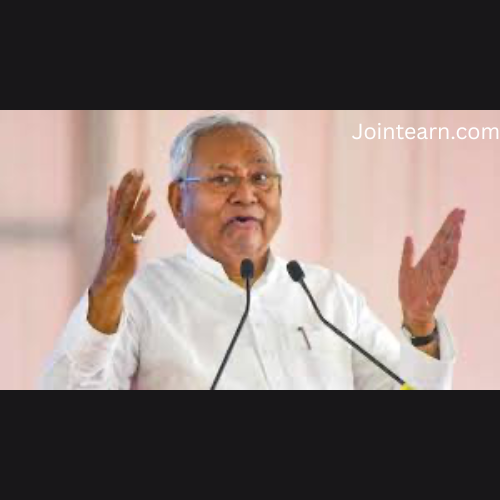
As Bihar moves closer to its 2025 Assembly elections, political momentum is rapidly building across the state, with both major alliances—the National Democratic Alliance (NDA) and the Mahagathbandhan—intensifying their campaigns. On Tuesday, Uttar Pradesh Deputy Chief Minister and BJP’s Bihar election co-incharge Keshav Prasad Maurya asserted that Chief Minister Nitish Kumar would once again assume office after the polls. Maurya’s confident declaration came as a sharp response to the Opposition’s claims and has injected a new wave of political energy into the NDA camp.
Speaking to reporters in Patna, Maurya dismissed the Mahagathbandhan’s claims as baseless and described their election promises as “fake.” He said that the political mood in Bihar clearly favored continuity, with Nitish Kumar set to lead the next government. “The announcements of the Mahagathbandhan are fake. Nitish Kumar will return as the Chief Minister of Bihar on November 14. The Mahagathbandhan is being wiped out,” Maurya stated. His remarks not only projected confidence in the NDA’s performance but also framed the upcoming election as a decisive verdict between what he termed as “fake promises” and “real development.”
Maurya’s statement came in the backdrop of intensifying campaigning by both alliances. The NDA, led by the Bharatiya Janata Party (BJP) and Janata Dal (United), is presenting a unified front, emphasizing development, stability, and governance continuity. The Mahagathbandhan, spearheaded by the Rashtriya Janata Dal (RJD) under Tejashwi Yadav’s leadership, is focusing its narrative on employment, social justice, and the alleged failures of the ruling coalition.
Janata Dal (United) leader Arun Kumar also reinforced Maurya’s confidence in Nitish Kumar’s leadership, asserting that the NDA would secure a decisive victory with a two-thirds majority. In a statement to the press, he highlighted the popularity of both Prime Minister Narendra Modi and Nitish Kumar, crediting their leadership for Bihar’s progress in recent years. “The feeling of the masses is that people with a positive mentality and development-oriented vision should continue to stay in the government. The caravan of PM Modi and Nitish Kumar should keep moving. The NDA is going to get a two-thirds majority in the elections,” he said.
Arun Kumar’s remarks echoed the broader sentiment within the NDA that the electorate values the alliance’s focus on governance and infrastructure. Over the years, Nitish Kumar has cultivated an image of an administrator dedicated to law, order, and development. Despite occasional political realignments, he continues to maintain a significant base of support among voters who associate his tenure with relative stability and infrastructural improvement in Bihar.
However, the political landscape has been stirred by recent statements from Mukesh Sahni, National President of the Vikassheel Insaan Party (VIP), who questioned Nitish Kumar’s ability to continue leading the state due to alleged health concerns. In his remarks, Sahni called for a generational shift in leadership, urging the public to give younger politicians an opportunity to govern. “There is a wave of change in the entire state. In 2005, people felt he should be given a chance. In 2010, he indeed did development in the state. In 2015, he became Chief Minister with Lalu Yadav’s support because he had nothing of his own. In 2020, he somehow became CM with the support of the BJP and VIP. We don’t have any complaints from him, but since he is unwell, he cannot be given the responsibility of the entire state’s population,” Sahni said.
Sahni’s comments, which suggest a need for leadership renewal, have sparked political debate across party lines. While the NDA has chosen to project Nitish Kumar’s experience and administrative record as its core strength, the Opposition is attempting to paint him as an aging leader unable to meet the aspirations of Bihar’s young population. This generational argument is central to the Mahagathbandhan’s strategy, particularly as the state’s demographics skew young and employment remains a pressing issue.
The upcoming 2025 Bihar Assembly elections are shaping up to be a significant contest between the NDA and the Mahagathbandhan. The NDA coalition currently includes the Bharatiya Janata Party (BJP), Janata Dal (United), Lok Janshakti Party (Ram Vilas), Hindustani Awam Morcha (Secular), and Rashtriya Lok Morcha. On the other hand, the Mahagathbandhan—a coalition of several opposition parties—is led by the Rashtriya Janata Dal (RJD) and includes the Congress, the Communist Party of India (CPI), the Communist Party of India (Marxist), and the Communist Party of India (Marxist-Leninist) Liberation (CPI-ML) under Dipankar Bhattacharya. Mukesh Sahni’s VIP has also joined the Mahagathbandhan after breaking away from the NDA earlier.
Adding another dimension to the contest is political strategist Prashant Kishor’s Jan Suraaj party, which has announced its intention to contest all 243 seats in the state. Kishor’s campaign has emphasized grassroots engagement and political reform, positioning Jan Suraaj as a third alternative to the established political blocs. Although it remains to be seen whether his movement can significantly impact the final results, it has added an element of unpredictability to the political equation in Bihar.
The Election Commission has announced that the Bihar Assembly elections will be held in two phases, on November 6 and November 11, with the results scheduled to be declared on November 14. This timeline sets the stage for an intense fortnight of campaigning, where alliances will seek to consolidate their voter bases and swing undecided segments in their favor.
Keshav Prasad Maurya’s remarks about Nitish Kumar’s likely return as Chief Minister on November 14 were clearly intended to project certainty and unity within the NDA ranks ahead of the polls. The statement also serves as a morale booster for party workers, reaffirming that the alliance leadership remains firmly behind Nitish Kumar. Political observers note that this clarity of leadership could give the NDA an advantage, especially in contrast to the Mahagathbandhan, where internal disagreements over leadership and seat-sharing have occasionally surfaced.
Nitish Kumar’s long political journey has been marked by multiple alliances and ideological shifts, yet his reputation as a pragmatic leader has allowed him to retain power for nearly two decades. His administration has focused on infrastructure development, road connectivity, women’s empowerment through reservation policies in local governance, and improving law and order—issues that continue to resonate with sections of Bihar’s electorate.
Nevertheless, the upcoming elections also pose challenges. Bihar continues to face chronic issues of unemployment, migration, and poverty. Critics argue that despite the NDA’s claims of development, many promises remain unfulfilled. The Mahagathbandhan, under Tejashwi Yadav, is seeking to capitalize on these issues, especially by appealing to the youth and lower-income groups. Yadav has consistently accused the government of neglecting employment generation and public welfare, positioning himself as the voice of change.
With both sides intensifying their campaigns, the Bihar election is expected to be one of the most closely watched political events of the year. The results, scheduled for November 14, will determine not only Nitish Kumar’s political future but also the balance of power between the BJP and regional allies within the NDA. For the Opposition, it is a test of whether the Mahagathbandhan can overcome internal divisions and present a credible alternative to the ruling coalition.
As things stand, the NDA appears confident, projecting Nitish Kumar as the face of governance and stability. The Mahagathbandhan, meanwhile, is betting on anti-incumbency sentiment and promises of rejuvenation. Amid these competing narratives, one thing is clear—the 2025 Bihar Assembly elections will serve as a defining moment for the state’s political landscape. Whether Nitish Kumar indeed takes oath once more as Chief Minister on November 14, as Keshav Prasad Maurya predicts, will depend on how voters ultimately weigh continuity against change in their quest for progress and development.

Leave a Reply